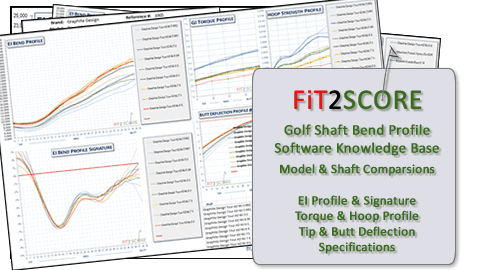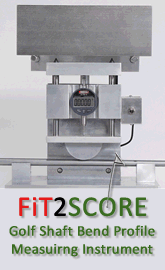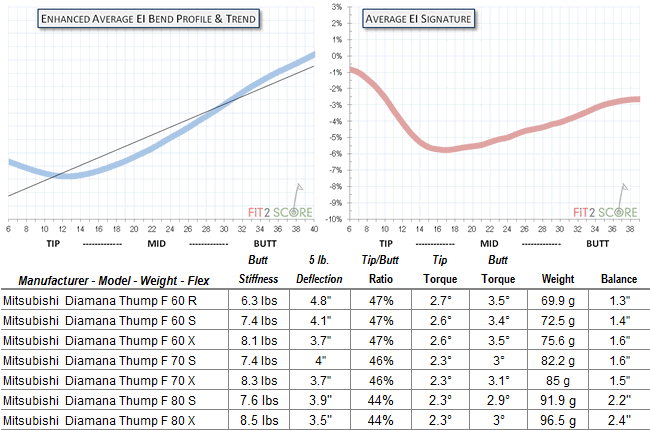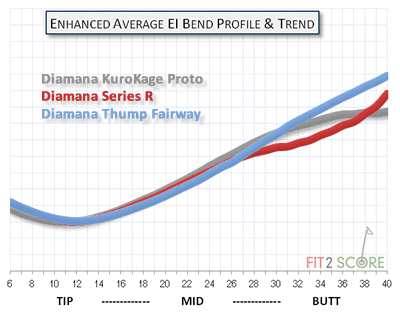MITSUBISHI FUBUKI DRIVER AND FAIRWAY SHAFTS

It was hard to miss noticing the Fubuki Tour on Television on Sunday afternoon. The distinctive white color is became so common it got copied by other brands. It is a variation of the White Board profile with a stiffer tip but softer mid. The second generation white board, the Diamana ‘ahina brought in an even stiffer tip. The Fubuki Tour shaft is now often used by tour players in fairways. The profile is similiar to the Diamana ‘ahina, with a softer, higher launching tip. The Fubuki Tour will be phased out in 2014. The profile of the Fubuki K offers the same feel and loading characteristics with a slightly stiffer tip.
The softer tip of the The Fubuki Tour introduced a slightly higher launch to the popular White Board design. It is a perfect pairing for a player looking for a slightly higher launching fairway, while still retaining the feel and control of a mid stiff shaft. Like all Mitsubishi Rayon golf shafts, the profiles of the Fubuki Tour are consistent from weight to weight and flex to flex. The butt torque ranges from 4.1 in the 50R to 2.6 in the 80X. The tip torque of the Fubuki Tour 70 and 80 x is 2.0, a great number for a fairway shaft.
Mitsubishi Fubuki Alpha

A 2010 profile from Mitsubishi called “Acceleration Technology”. It is promoted as delivering high launch and low spin. I have found it to be a mid to low mid launching golf shaft design. I refer to this as a Kai’li on steroids. The profile is a blend of the ‘ahina and Kai’li designs.
It is available in 55 – 75 grams. Among the sub 60 gram shafts it is unique. A tour profile in a light weight shaft. The butt is not as stiff as the Kai’li and the mid is not as soft. The tip is tight in both longitudinal and radial directions. The white driver shaft you saw on TV on weekends, this was it until the Fubuki K came along. The overall torque of the Fubuki Alpha ranges from 4.1 in the 50R to 2.5 in the 80X. The Fubuki Alpha profiles are consistent from weight to weight and flex to flex. The radial profiles are excellent; the shaft can be used in any orientation. The Fubuki Alpha 65 gram is the stock shaft in the 2012 Adams Fast 12 LS driver. That makes the Adams Fast 12 LS driver a unique value proposition.
Mitsubishi Fubuki K

The Fubuki K was introduced in late 2011. The MDT shaft material is enhanced with a metallic “lace” in the butt section. This creates a stable butt without having to add a lot of carbon fiber. The profile called “Acceleration Technology” by Mitsubishi is similar to the original Fubuki Tour with a slightly firmer butt and tip.
The Fubuki K, unlike the Fubuki Alpha profile, is very similar to the ‘ahina with a higher tip to butt ratio resulting is a higher launch. It is a soft tip ‘ahina. The torque ranges from 4.1 in the 50R to 2.5 in the 80X shafts. The tip torque of this shaft is among the lowest I have measured. The Fubuki K profiles are consistent from weight to weight and flex to flex. The radial profiles are excellent; this shaft can be used in any orientation. Yes, the tour version 80X is in my driver fitting system for you gorillas out there. Like the original Fubuki Tour, it is a perfect compliment to the ‘ahina as a higher launching, higher spinning fairway shaft.
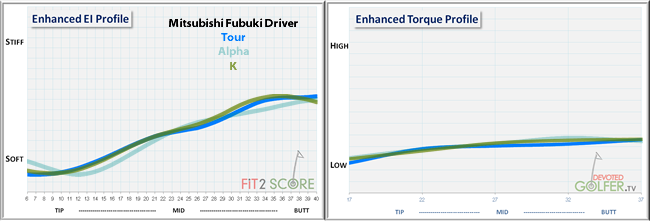
A look at the EI profiles of the Mitsubishi Fubuki golf shafts shows the similarity between the original Tour and the third generation K versions. The Alpha is a different design and launches lower.
Mitsubishi Fubuki Ax Fairway

The Fubuki Ax is a fairway shaft. The raw shaft is several inches shorter than a driver shaft. The weights range from 50 to 85 grams. It is a close match to the Diamana Blue Board. The profiles and torques are much the same. Its a mid high launching shaft. The Fubuki Ax fairway is a mid price shaft, making for economical fairway clubs with a high performance shaft. The comparison with the Fubuki Alpha is shown below. A stiffer butt design follows the preference of many tour players in their fairways. The overall torque of the Fubuki Ax Fairway ranges from 4.3 in the 50R to 3.1 in the 80X. Tip torques on the heavier, stiffer versions are around 2.5. The Fubuki Ax profiles are consistent from weight to weight and flex to flex. The radial profiles are good; the shaft can be used in any orientation. The 65 gram version of the shaft is standard in the Adams 2012 Super XTD fairway.
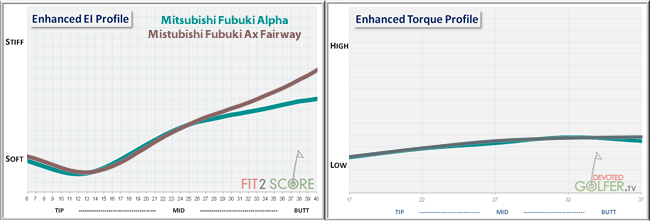
As with all Mitsubishi shafts, you should see a club fitter to select the best fit of profile, weight and stiffness to your swing.
![]() Golfers who first experience a fairway with a premium driver shaft universally have a jaw dropping experience. First at the performance then at the cost of the fairway club. There is sticker shock when they are told the shaft itself cost more than a retail fairway metal. Yet, when you see a tour player hitting a fairway you should realize, the shaft he is using is the same quality as his driver shaft. Heavier and perhaps stiffer, but it is an ultra-premium driver shaft.
Golfers who first experience a fairway with a premium driver shaft universally have a jaw dropping experience. First at the performance then at the cost of the fairway club. There is sticker shock when they are told the shaft itself cost more than a retail fairway metal. Yet, when you see a tour player hitting a fairway you should realize, the shaft he is using is the same quality as his driver shaft. Heavier and perhaps stiffer, but it is an ultra-premium driver shaft.

